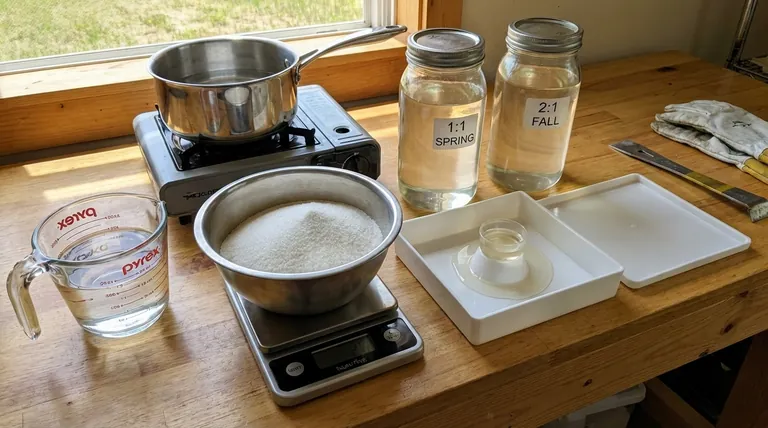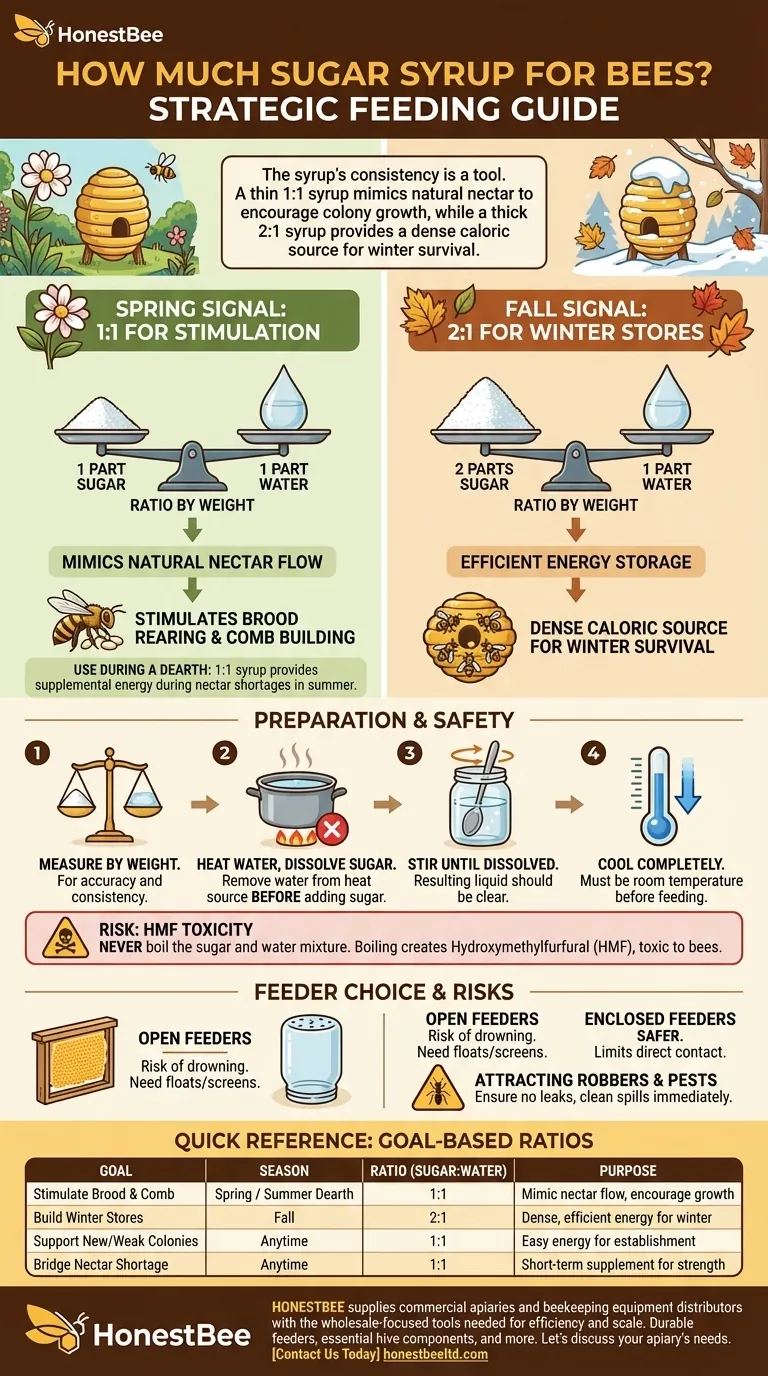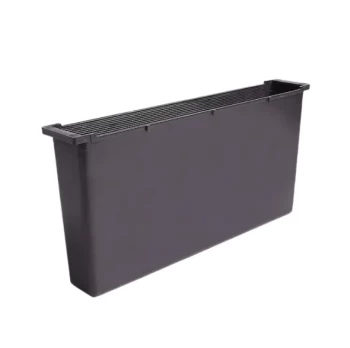The correct sugar syrup ratio for bees depends entirely on your goal and the time of year. For spring, when you want to stimulate brood rearing and comb building, a 1:1 ratio of sugar to water by weight is the standard. For fall, when the goal is to help bees build dense winter food stores, a heavier 2:1 ratio of sugar to water is used.
The question is not just "how much sugar," but "why am I feeding my bees?" The syrup's consistency is a tool. A thin 1:1 syrup mimics natural nectar to encourage colony growth, while a thick 2:1 syrup provides a dense caloric source for winter survival.

Why the Ratio Changes with the Season
Understanding the purpose behind feeding is the most critical part of the process. You are not just providing food; you are sending a signal to the colony that influences its behavior.
The Spring Signal: 1:1 Syrup for Stimulation
In early spring, a 1:1 syrup (equal parts sugar and water, by weight) closely mimics the consistency of natural nectar flow.
This thin syrup tells the queen that resources are abundant, which stimulates her to lay eggs and expand the brood nest. It provides the energy worker bees need to begin drawing out new comb.
The Fall Signal: 2:1 Syrup for Winter Stores
In the autumn, a thick 2:1 syrup (two parts sugar to one part water, by weight) serves a different purpose. It is less about stimulation and more about efficient energy storage.
Bees can process this dense syrup into "honey" stores with less effort, as they have to evaporate less water. These concentrated stores are what they will consume to generate heat and survive the cold winter months.
When to Feed During a Dearth
A nectar dearth is a period during the summer when flowers are not producing nectar. If a colony is large and active but natural forage is scarce, a 1:1 syrup can provide supplemental energy and prevent the colony from consuming all its winter stores prematurely.
How to Prepare Syrup Correctly and Safely
The preparation method is simple but has critical steps that ensure the syrup is beneficial and not harmful to your bees.
Step 1: Measure by Weight
For accuracy, always measure your sugar and water by weight, not by volume. A kilogram of sugar and a kilogram of water for a 1:1 ratio, for example. This ensures consistent results.
Step 2: Heat Water and Dissolve Sugar
Heat the water in a pot. You can bring it to a gentle boil, but it is not strictly necessary. Remove the water from the heat source before adding the sugar.
Pour the granulated white cane sugar into the hot water and stir until all crystals are completely dissolved. The resulting liquid should be clear.
Step 3: Cool Completely
This is a critical safety step. The syrup must be cooled to room temperature before you give it to the bees. Hot syrup can seriously injure or kill them.
Understanding the Trade-offs and Risks
Feeding is a powerful management tool, but it is not without risks. An objective beekeeper must understand the potential downsides.
The Danger of Boiling: HMF Toxicity
Never boil the sugar and water mixture. Boiling sugar can create a compound called Hydroxymethylfurfural (HMF), which is toxic to bees. This is why you must remove the water from the heat before adding the sugar.
Choosing the Right Feeder
The type of feeder you use impacts bee safety. Open feeders, like frame feeders or top feeders, can cause bees to drown if proper precautions (like floats or screened-off areas) are not taken.
Enclosed or inverted feeders, such as a Mason jar or a bucket with small holes in the lid, are generally safer as they limit the bees' direct contact with large pools of liquid.
Attracting Robbers and Pests
The smell of sugar syrup can attract bees from other colonies (robbing) as well as ants and wasps. Ensure your feeders are placed inside the hive and do not leak. Any spills on or around the hive should be cleaned up immediately to avoid inciting a robbing frenzy.
Making the Right Choice for Your Goal
Base your feeding strategy on a clear objective for the colony's health and the current season.
- If your primary focus is stimulating spring brood rearing: Use a thin 1:1 syrup to mimic a natural nectar flow.
- If your primary focus is building robust winter food stores: Use a thick 2:1 syrup in the fall for efficient, dense energy storage.
- If your primary focus is supporting a new or weak colony: Use a 1:1 syrup to provide easy energy for comb building and population growth.
- If your primary focus is bridging a temporary nectar shortage: Use a 1:1 syrup as a short-term supplement to maintain colony strength.
By matching the syrup ratio to the colony's needs, you transition from simply feeding bees to strategically managing their health and productivity.
Summary Table:
| Goal | Season | Recommended Ratio (Sugar:Water) | Primary Purpose |
|---|---|---|---|
| Stimulate Brood Rearing & Comb Building | Spring / Summer Dearth | 1:1 | Mimics nectar flow to encourage colony growth |
| Build Winter Food Stores | Fall | 2:1 | Provides dense, efficient energy for winter survival |
| Support New or Weak Colonies | Anytime | 1:1 | Provides easy energy for establishment and growth |
Ensure Your Apiary Thrives with the Right Supplies
Strategic feeding is just one part of successful beekeeping. Equip your operation with durable, high-performance gear designed for commercial success.
HONESTBEE supplies commercial apiaries and beekeeping equipment distributors with the wholesale-focused tools needed for efficiency and scale. From durable feeders to essential hive components, we provide the reliable equipment that supports healthy, productive colonies.
Let's discuss your apiary's needs. Contact our team today to learn how our wholesale solutions can enhance your operation's productivity and profitability.
Visual Guide

Related Products
- HONESTBEE Professional Hive Top Bee Feeder Feeding Solution
- HONESTBEE Round Hive Top Bee Feeder for Syrup
- HONESTBEE Entrance Bee Feeder Professional Hive Nutrition Solution for Beekeeping
- HONESTBEE Advanced Ergonomic Stainless Steel Hive Tool for Beekeeping
- Rapid Bee Feeder White Plastic 2L Round Top Feeder for 8 or 10-Frame Bee Hives
People Also Ask
- What should be done with feeders and equipment after feeding bees? Essential Steps for Apiary Health
- What are the advantages of hive top feeders? Maximize Feeding Efficiency for Your Apiary
- What features make top feeders a reliable choice for beekeepers? A Guide to Safe, Efficient Hive Nutrition
- What is a top feeder for bees? Maximize Colony Health with Efficient Feeding
- How is the plywood floor fitted into the hive-top feeder? Ensure Longevity with a Floating Floor Design



















